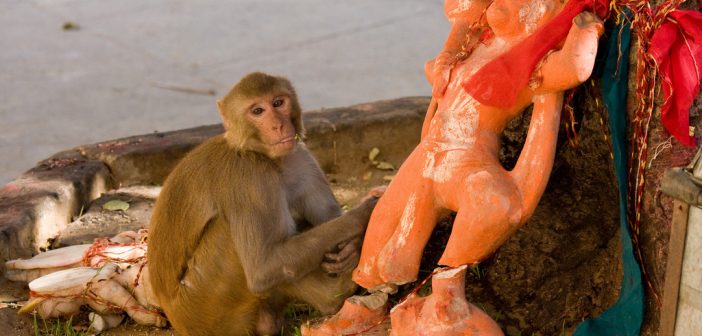(Featured image: monkey at Galtaji temple outside Jaipur. Credit Garrett Ziegler, CC BY-NC-ND 2.0)
Hindu temples have been since time immemorial the centre of worship in India. According to Hindu mythology, there exist 33 crore [330 million] gods and goddesses. Temples are hence dedicated to these gods and goddesses, along with animals and non-living creatures.
Hindu gods and goddesses alike are depicted as the protectors of animals, whom they are often shown riding.
Lord Shiva is said to ride the Nandi bull, Lord Vishnu rides the Garuda eagle, Lord Ganesh rides the rat, Lord Murugan rides the peacock and Goddess Durga rides the lion, to name a few.
Lord Shiva is also known by the name of “Pashupatinath”. ‘Pashu’ in Sanskrit means ‘animals’ and in some texts refers particularly to the ‘cow’.
Every Shiva temple is accompanied by the figure or sculpture of the Nandi Bull right in front of the Shiva Linga.
Not only did all the major temples maintain goshalas, or cow sanctuaries, but animals were inherent in the temple architecture.
A huge ancient sculpture of Nandi is seen in the Brihadeshwara temple in Thanjavur.
The importance of animals in Hindu temples is demonstrated by the fact that some temples’ worship is incomplete without the animals. Some examples of such temples include the following:
The Rat temple or Karni Devi Temple:
This temple is located about 30 km. from Bikaner in Rajasthan state. The Karni Devi temple is regarded as the rat temple due to its famous 20,000 rats who live here. Never has their number been seen to increase or decrease, and no one has ever seen a baby rat. The Prasad, or blessed food, cooked here is shared by the rats and humans alike, and not a single case of disease or plague has ever been reported.
The Monkey Temple or the Galtaji Temple:
Monkeys have been sacred in Hinduism since the time Lord Hanuman helped Lord Ram in his fight against Ravana, as told in the Ramayana. Several temples are dedicated to Lord Hanuman, but a special one 10 km. from Jaipur is famous for its monkey inhabitants.
The Snake Temples:
Various festivals exist in India that worship snakes, such as Shivratri and Nag Panchami. Serpents occupy a special place in Hindu mythology.
The Mannorasala Temple in Kerala has 30,000 images of snake idols along its path. Women come here seeking fertility.
The Kukke Subramanya Temple in Karnataka is dedicated to Lord Subramanium, and devotes come here for Sarpa Dosha Nivarana that is inherent in the natal birth chart.
Other examples are the Bhujang Nath Temple in Gujarat, the Tirunageshwaram Temple, and the Sheshnag Lake in the Kashmir valley. Myth says that it was created by Sheshnag himself, the king of serpents on whom Lord Vishnu rests.
Temple for Dogs:
In Chennapatna taluk in Karnataka, there are two idols of dogs that are worshipped.
Dattatreya Temple at Kala Dungar:
Another classic example of animal worship in temples is the Kala Dungar.
The “Kala Dungar” or the Black Hill is the highest point in the Rann of Kutch. A panoramic view of the Rann and the forest is possible from here. It is famous for its Dattatreya Temple.
Legend has it that when Lord Dattatreya practiced penance at this place, a band of starving jackals came there. Lord Dattatreya offered parts of his body, and the parts or limbs regenerated themselves. However, the hungry jackals refused to eat his body parts. Then the Lord offered his sweet rice which they readily ate. After that they came everyday twice to eat the sweet rice. This practice has continued up to the present, and each day rice cooked with jaggery is offered after noon and evening arti, and the jackals come and take the Prasad.
It is considered inauspicious if the jackals do not come to eat. This happened in 2001, and a few days afterward there was a major earthquake in the region.
__
Hindu philosophy not only emphasizes the great importance of the animal kingdom in its temple worship, but the very manifestation of nature or “Prakriti” is itself connected to the worship of Uma or Shakti, the consort of Lord Shiva. The interdependence of worship, gods, man and animals is glorified in the spiritual ideals of Hinduism.






1 Comment
The reference of “Lord Shiva is also known by the name of “Pashupatinath”. ‘Pashu’ in Sanskrit means ‘animals’ and in some texts refers particularly to the ‘cow’.” is a misconception. Pashu stands for Harmless people for who God is the protector. Pashu here is not animal. Pashupati alone is enough. Sorry if I intervened you.r posting.